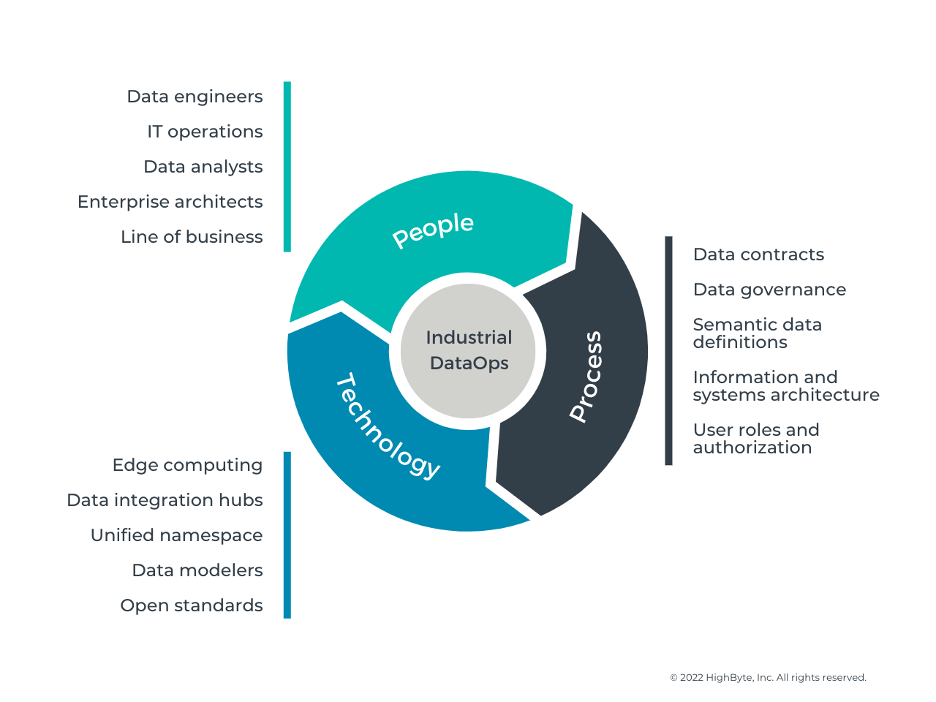The state of DataOps in manufacturing in 11 stats
Today, global leaders see manufacturing as the engine powering a wide range of initiatives—from infrastructure development to energy efficiency. Their focus on industrial growth and sustainability shouldn’t be surprising considering manufacturing accounts for roughly 17% of the global GDP and 23% of direct carbon emissions. The reprioritization of industrial investments around the world is good news for manufacturers.
Now for the bad news.
Manufacturers lag other sectors by a significant margin when it comes to data management.
Enterprise Strategy Group (ESG) surveyed 403 technical and business data professionals at organizations in North America to assess the state of DataOps in 2022. They defined DataOps as “improving the quality, delivery, and management of data and analytics at scale.” The study looked at market maturity, challenges, factors influencing buying and planning decisions, and business benefits among those surveyed.
The findings were telling.
95% of manufacturing organizations indicate they’re struggling with their data management and analytics initiatives. Manufacturers’ problems with data management are putting them at a competitive disadvantage. Just 28% of manufacturers believe their DataOps strategy is very effective compared with 57% from other industries. Additionally, only 38% of manufacturers believe they exceed their peers or competition in leveraging data analytics vs. 61% from other industries.
So, what now?
People, Process, and Technology
An effective DataOps strategy requires the orchestration of people, process, and technology. Only with these three elements working in concert can we deliver trusted, business-ready data to users and systems that require it.

People
Only 16% of manufacturers indicated they have significantly increased end-user access to data within their organization over the last year compared to 47% of respondents from all other industries. Without real-time insights, meeting new productivity demands, improving product quality, reducing operations costs, and outperforming competition becomes virtually impossible in an Industry 4.0 world.
In some cases, manufacturers are trying to solve their data management problems with impractical solutions. For example, 42% of manufacturers say they plan to hire more people to address ongoing data integration challenges compared to 34% in all other industries. Adding more talent is costly and difficult given the current skills shortage.
The findings demonstrate a need to prioritize DataOps within manufacturing enterprises. For instance, only 60% of manufacturers have a formal data operations team compared with 73% of respondents from all other sectors.
There is also the matter of burnout, which disproportionally affects IT Operations in manufacturing. In fact, 42% of manufacturers indicated that IT operations is more overburdened with DataOps strategy than any other job function within their organization—compared to only 16% for this role in other industries.
To address these shortcomings, consider these questions:
- Do I have the right cross-functional team to accomplish our goals?
- Do I have the resources (human and financial) I need to be successful?
- Is this initiative a priority, driven from the top down?
Process
Manufacturers realize they need data to become more efficient. In fact, 68% of manufacturers responding to the ESG survey cite operational efficiency as the top business objective driving their data strategy.
The problem lies in execution. Traditionally, data preparation and orchestration has been tied to transactional data rather than operational data from machines, processes, and products. Perhaps that’s why other sectors, such as finance, are more mature when it comes to DataOps.
Furthermore, 25% of manufacturers say resistance to change and cultural differences are major barriers they face in their DataOps strategy compared to 19% in other industries.
To address these challenges, here are a few questions to consider:
- Do we have alignment on use cases, data sources, and requirements of end applications?
- Do we have the right system architecture that will allow us to scale?
- Does our company culture promote data democratization and real-time action on insights by operators?
Technology
Technology is not a cultural Band-Aid, but it can help address some of the challenges experienced by People and Process. Unfortunately, 64% of organizations have significant room for growth when it comes to implementing DataOps technology—and manufacturing is slightly behind the curve.
The message from the ESG survey is clear: If manufacturers want to leverage the full potential of data analytics, DataOps must be a core part of their digital transformation strategy. Once manufacturers have a solid plan in place, they need data modeling solutions that can automate IT/OT integrations then standardize and contextualize that information in real time, so operations can focus on their core responsibilities, and IT can deliver information to line of business without burnout.
The good news is that 97% of manufacturing organizations are benefiting from improved access and usage of data for outcomes like supply chain optimization and predictive maintenance. So, making improvements across People, Process, and Technology is well worth the effort.
If you’d like to learn more about the State of DataOps, download the eBook discussed in this post.
About the author
 Torey Penrod-Cambra is the Chief Communications Officer of HighByte, focused on the company’s messaging strategy, market presence, and ability to operationalize. Her areas of responsibility include marketing, public relations, analyst relations, investor relations, and people operations.
Torey Penrod-Cambra is the Chief Communications Officer of HighByte, focused on the company’s messaging strategy, market presence, and ability to operationalize. Her areas of responsibility include marketing, public relations, analyst relations, investor relations, and people operations.



